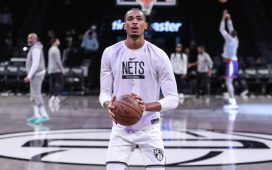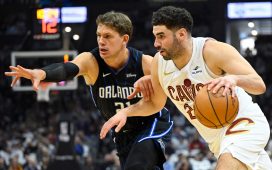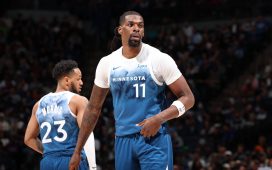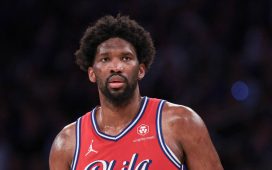SAN ANTONIO — Bryn Forbes spent his first year in the N.B.A. shuttling between San Antonio and Austin, Texas, in his 2010 Chevrolet Impala. He became very familiar with the 80-mile stretch of Interstate 35 that connects the two cities. Sometimes he played music. Sometimes he talked on the phone. Sometimes he drove in silence.
“It’s almost like meditation,” he said, “just driving and thinking.”
There were moments in that 2016-17 N.B.A. season when Forbes would think about his uncertain future as an undrafted shooting guard without a guaranteed contract. Or about the game ahead of him that night with the Austin Spurs, San Antonio’s G League affiliate. Or about his drive back to San Antonio the following morning, for practice with the team he dreamed of joining full time.
Now that Forbes, 26, starts for the Spurs and averages 12.9 points, with a potential payday ahead of him next summer as an unrestricted free agent, he often finds himself reflecting on his unlikely path.
“I wouldn’t change anything about what I went through, because it’s kind of created who I am now — the work ethic, all of it,” Forbes said. “But I don’t know if I could do it again.”
Forbes is not alone in this golden age for undrafted players. Fred VanVleet is fresh off a championship with the Toronto Raptors. Alex Caruso has emerged as a defensive stopper for the Los Angeles Lakers. Aron Baynes has been throwing his weight around for the Phoenix Suns. And in Miami, Kendrick Nunn and Duncan Robinson are doing crazy things for the Heat, like combining for 70 points in a recent overtime win against the Atlanta Hawks — the most points ever by a pair of undrafted teammates.
As the game has gone global, there are more prospects than ever — because there are more good players than ever. And they cannot all be among the meager 60 draft picks every June.
“You’re not going to get it right 60 times,” said Wesley Matthews, a veteran guard with the Milwaukee Bucks who went undrafted out of Marquette in 2009. “The pool is a lot bigger than what it appears to be.”
At the same time, there are more opportunities for the unsung, for the unheralded. After a then-record 92 undrafted players got minutes during the 2016-17 season, the league expanded the maximum size of team rosters from 15 to 17, and the number of undrafted players jumped to 136 the following season, according to N.B.A. Advanced Stats.
Already this season, more than 100 undrafted players have found their way onto the court — and many are playing important roles. They are also part of an informal fraternity that has survived rigors unfamiliar to the league’s more intergalactic stars. Like playing in the G League. Or wondering whether they would get cut during lunchtime.
“You’ve got to be focused and driven towards one thing, and it’s a hard journey,” Caruso said. “If you’re not, and you waver one way or the other, you’ll be gone tomorrow.”
After he went undrafted, Matthews coped with his emotions — “I’d imagine it’s a tremendous feeling to have your name called,” he said — and eventually signed a nonguaranteed deal with the Utah Jazz. He spent his first couple of months with the team at a hotel. By December, he had moved into a small apartment, but his lease was month to month because he had no idea whether the Jazz would keep him around. It turned out they wanted him to stay.
Even now, after having earned more than $100 million over 11 seasons, Matthews can remember the morning when the Jazz guaranteed his first contract.
“A lot of everything goes into it for undrafted players who make something out of it,” Matthews said. “A lot of preparation, a lot of sacrifice, a lot of skill, a lot of luck.”
The hunger of undrafted players can even be part of their appeal. Spurs Coach Gregg Popovich has a soft spot for players of their ilk. His team has had its share of undrafted players: Avery Johnson, Bruce Bowen, Jonathon Simmons.
“I think those guys understand they have to work harder than other people,” Popovich said, “and they usually do.”
Forbes appreciates the challenges better than most. For so much of his life, he said, he felt overlooked and overshadowed. Lightly recruited in high school, he landed at Cleveland State. He later transferred to Michigan State, where he shot 48.1 percent from the 3-point line as a senior. But he was not among the more than 60 players invited to the N.B.A.’s annual scouting combine, and most draft prognosticators ignored him.
Considered undersized for his position at 6 feet 2 inches, Forbes had predraft workouts with 12 teams, including San Antonio. He impressed one Spurs person in particular: Chip Engelland, an assistant who was enthralled by what he described as Forbes’s “repeatable” shooting stroke.
“It was obvious he was someone who had put in a lot of time,” Engelland said. “It would be like if you heard a great pianist. His shot was that pure.”
Popovich also attended the workout. His recollection: “Good kid. Shoots the ball. Kind of small.”
A few days later, Forbes watched the draft on television at his mother’s house in East Lansing, Mich. His agent, Mike Lindeman, told him that a couple of teams were interested in selecting him in the second round to do a “draft and stash,” meaning they wanted to secure his rights so they could send him to Europe or straight to the G League for an indefinite period of seasoning. Forbes told Lindeman to politely decline. He wanted to weigh his options and control his future.
As a result, he was at peace with himself on draft night. In fact, he fell asleep. It was over by the time he woke up after midnight, and he saw that he had missed several phone calls, including one from Jordan Howenstine, a childhood friend who was working in the Spurs’ communications department. They used to car pool to school. Now, Howenstine was telling Forbes that the Spurs’ front office had been trying to reach him for about 15 minutes: Why wasn’t he answering his phone?
“I was sleeping, bro,” Forbes told him.
Though Forbes said the Spurs and the 76ers were both interested in signing him to nonguaranteed deals, the Spurs were especially assertive.
“We weren’t going to leave that night until we signed him,” Engelland said.
Most borderline prospects who find gainful employment in the N.B.A. have an invaluable and easily identifiable skill, Popovich said. He cited Dennis Rodman (rebounding) and Patrick Beverley (defending) as high-profile examples who were both second-round picks.
“If you have a skill, you have a chance to interest somebody at some point,” Popovich said.
With Forbes, that special skill was his perimeter shooting. But Popovich told Forbes early on that he would never make it if he did not improve his defense. Popovich also told him that he would be spending most of his first season in the G League, where Popovich wanted him to spend time at point guard, a position Forbes had never played.
“You’ll be so much more valuable if you can play two positions,” Forbes recalled Popovich telling him.
The prevailing feeling for Forbes that first season was pressure: pressure to learn, pressure to adapt, pressure to survive the traffic on his drives to Austin, and pressure to find his way back to the Spurs. But he knew how to work, because it was all he had ever known, and that much was clear to the coaching staff from the start.
“An incredible work ethic,” Engelland said. “He just tries really hard, which is a huge Coach Pop thing.”
Late that season, Forbes spent a long stretch with the Spurs and had a game to remember against the Dallas Mavericks: 27 points on 10-of-19 shooting in a 13-point win. It helped catapult him into the rotation the following season.
“I’m really proud of him,” Popovich said, adding: “Bryn’s not going to be LaMarcus Aldridge or Tim Duncan. But he’s O.K. with it. He just wants to improve as an individual as much as he can.”
Forbes became a full-time starter last season after signing a two-year deal with the Spurs worth $6 million.
“They had a plan for me,” Forbes said. “And I don’t think anyone knew — not even them — how things would turn out. But they had a plan to help me grow.”








